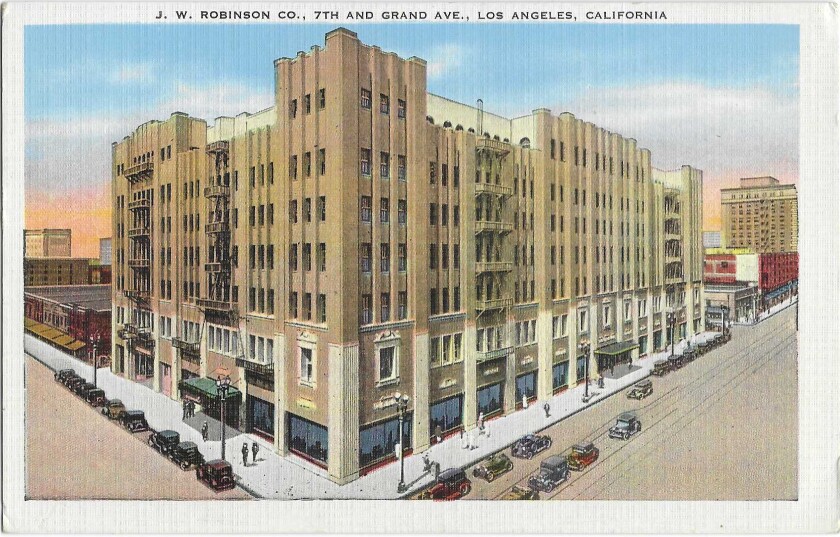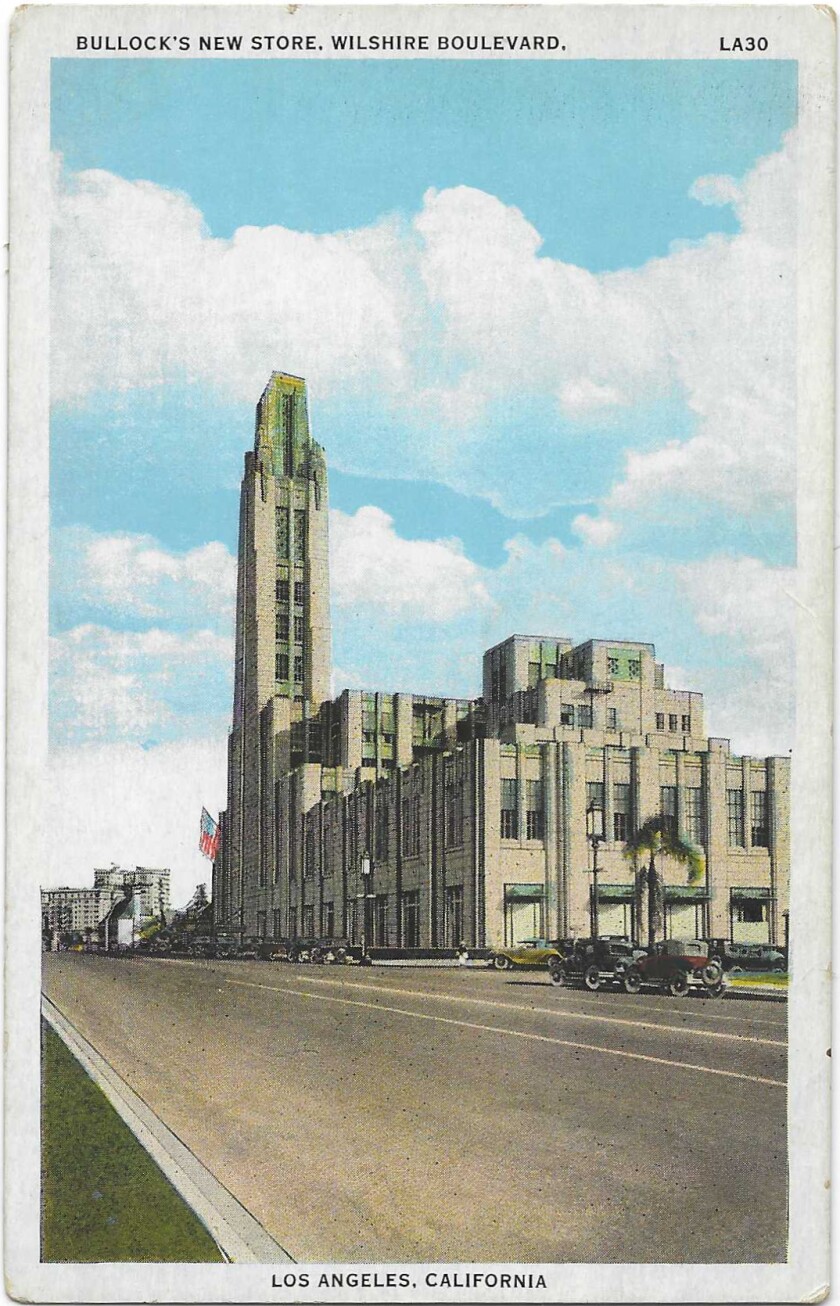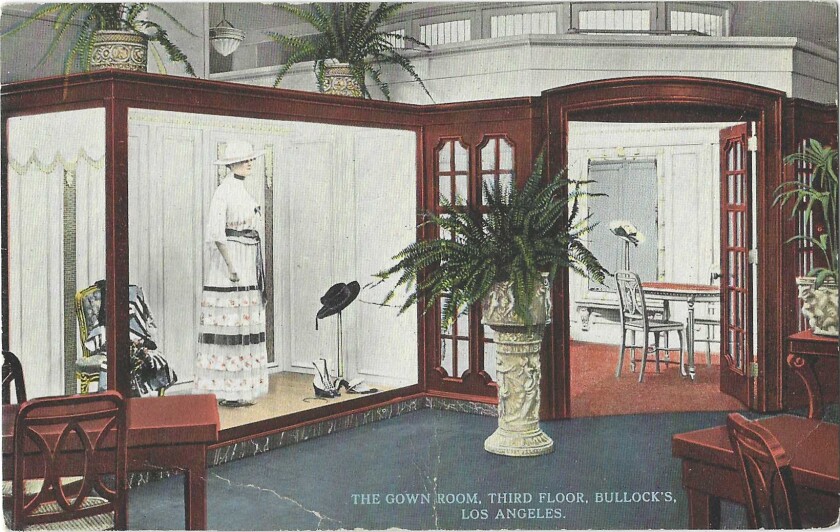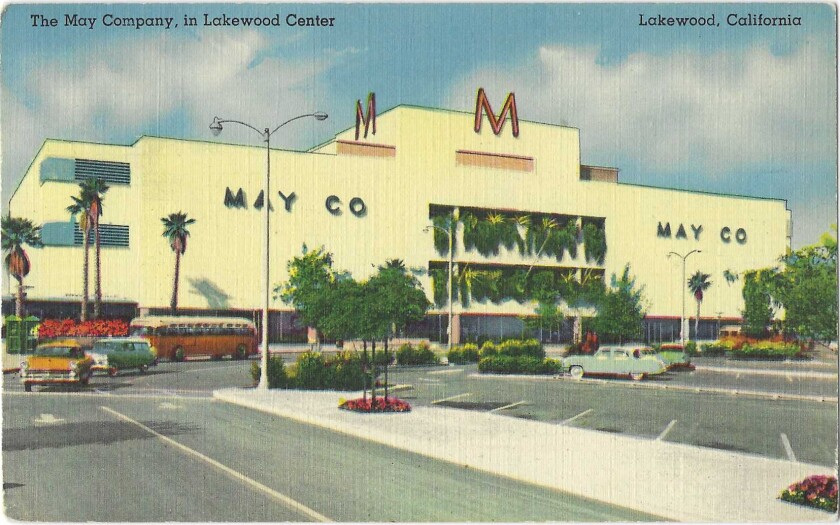“Store until you drop” didn’t at all times imply “store until your telephone drops out of your trembling, bargain-hunting hand.”
For an excessively lengthy whilst, “going looking” in Los Angeles, particularly for the vacations, intended hanging on actual garments and footwear unsuited to a bath stall, and taking a experience — an journey, actually — to the showplaces of mercantile Los Angeles.
L.A. has been in this journey for just about 150 years, in the course of the peak-and-slide fortunes of the huge downtown flagship division shops, in the course of the centrifugal unfold of suburban department shops, and the invasion of that unpleasant moneymaker referred to as the mini-mall — lengthy earlier than there was once any web to buy groceries on.
Foods and drinks shops naturally got here first; the earliest Ralphs grocery opened in 1873 in downtown, and Albert Cohn operated a number of branches of his fancy meals retail outlets. Dry items shops, the forerunner of division shops, flourished too.
With the growth of the Eighties that inflated the town’s profile and lifestyle, Los Angeles’ muckety-mucks sought after all that massive, refined towns had on be offering too, and the nice division retailer technology was once on. And should you assume we’re “over-stored” now, to make use of a marketplace research word from the Eighties, believe the downtown shopping-scape of the Eighties and past, maximum of them clustered within the few blocks round seventh Boulevard and Broadway.
The Town of Paris division retailer, begun within the rough-and-ready 1850s as S. Lazard and Corporate, for Solomon Lazard. His bookkeeper/clerk and long run spouse, Eugene Meyer Sr., had come right here from France and later took over the company, renamed it the Town of Paris, and bought it round 1883. His son, Eugene Meyer Jr., was once born right here, and Meyer Jr. ultimately revealed the Washington Put up — as did his daughter, Katharine Graham.
Hamburger’s
The immense, and immensely fashionable Hamburger’s, and A. Hamburger and Sons, firstly “The Other people’s Retailer.” What was once based in 1881 as a modest basic retailer on Major Boulevard, with the newness of no-haggling costs, quickly had a beautiful five-story, half-block footprint. On an undated and unsent antique postcard of the shop, somebody wrote in wonderful script, “That is our biggest Division Retailer. They bring the whole thing. It strikes a chord in my memory of Marshall Fields in Chicago or Wanamaker’s in N.Y.” — tune to the ears of L.A.’s industrial aristocrats.
Those self same aristocrats had been at that time plainly too reasonable to advertise a purpose-built, publicly owned library development, so L.A.’s public library opened at the 3rd flooring of Hamburger’s in 1908. One new librarian, consistent with the town library’s personal historical past, “was once surprised to listen to the elevator operators name out the library flooring between the ladies’s put on and the furnishings.” The library moved in 1913 to every other rented area, however now not earlier than a tender scientific pupil who got here in in the course of the Hamburger’s front controlled to smuggle a whole set of scientific encyclopedias out of the library.

Hamburger’s, observed on a postcard from Patt Morrison’s assortment, was once based in 1881 and was once house to Los Angeles’ public library from 1908 to 1913.
Would possibly Corporate
The Would possibly Corporate opened for trade in Leadville, Colo., in 1877, promoting Levi’s and lengthy johns to miners. David Would possibly purchased out Hamburger’s in 1923. In 1939, the most productive yr for motion pictures in movie historical past, the architecturally hanging Would possibly Corporate development opened on Wilshire Side road; it’s now the house of the Movement Image Academy’s museum.
Robinson’s

“The Robinson Retailer is among the display puts of Los Angeles,” consistent with this antique postcard from Patt Morrison’s assortment.
Opened in 1883 on the nook of Spring and Temple streets because the Boston Dry Items retailer, the renamed, grander retailer took the identify of its founder, J.W. Robinson’s, moved to the fabulous, filthy rich precincts of seventh Boulevard in 1915, and in time was a powerhouse chain of department shops.
Broadway

A postcard from Patt Morrison’s assortment with a 1908 postmark presentations the eating place on the Broadway Division Retailer in Los Angeles.
The Broadway, flagship of a long run chain, opened in 1896 downtown and in 1931 in Hollywood, the place its stark rooftop signal “The Broadway Hollywood” nonetheless glows above Hollywood Side road, and the place the shop’s founder, Englishman Arthur Letts, constructed a limiteless lawn, which was once bought off and plowed underneath after Letts died, even though some cacti had been moved to the Huntington’s gardens. Letts helped to arrange one in all his workers in trade with every other retailer, recognized through that guy’s identify …
Bullock’s

The again of this postcard from Patt Morrison’s assortment says that Bullock’s Wilshire is “the place the elite of Hollywood and Beverly pass to buy.”
… Bullock’s. Possibly the dept retailer identify maximum related to L.A., the primary retailer opened in 1907 downtown, and in time Bullock’s had a couple of ranking of shops throughout Southern California, together with the Pasadena and Westwood shops, which crafted their very own clothes labels. Probably the most impressive was once Bullocks Wilshire, an Artwork Deco masterpiece and the surviving anchor development for the pre-Global Conflict II glamorous Miracle Mile looking district — its developer longed for it to transform the “5th Street of the West.”
In the future within the Seventies, its identify misplaced the apostrophe utilized by its lesser sisters. It was once essentially the most sublimely chic and wonderful division retailer in California, as proved when, years someday, the brand new proprietor, Northern California Macy’s/I. Magnin, made off with fixtures from the traditionally vital 1929 development, and needed to convey 166 of them again. It carried essentially the most opulent strains of clothes and comfort items on the planet, or even the impoverished hoi polloi like me may stroll round its vitrines with the appreciation you’d give to a museum, which is how moderately the items had been displayed. The vendeuses, as sublime as their Parisian opposite numbers, as soon as incorporated younger Angela Lansbury. And long run First Woman Pat Nixon, as a faculty pupil, was once a Bullocks Wilshire assistant purchaser (telephone quantity Fitzroy 5212). The shop’s true front wasn’t on Wilshire however in the course of the drive-up porte-cochere at the back of the shop, its ceiling ornamented with a mural referred to as “The Spirit of Transportation.”
It’s now Southwestern Legislation College. As for the “5th Street of the West,” it was once for a time so promising that during 1962, the Jap division retailer Seibu opened a department at Wilshire and Fairfax. It closed two years later as a result of, an government VP defined, to stay going, it needed to “lift products that weakened the identification” of its Jap emblem. The Petersen Car Museum stands at the web site now.
Buffums
Buffums — which additionally as soon as had and misplaced an apostrophe — was once a Lengthy Seashore-based retailer that set itself up in trade in 1904 and in time opened greater than a dozen branches from San Diego to Glendale. Its most famed circle of relatives member was once Dorothy Buffum Chandler, “Buff,” the spouse of Instances writer Norman Chandler, and a energetic philanthropist and civic chief who dreamed and muscled the Los Angeles Track Heart into lifestyles.
Ville de Paris
The Ville de Paris retailer, based in 1893 at the web site of as of late’s Grand Central Marketplace through Auguste Fusenot, one of the most nice wave of French immigrants who introduced their wine-grape shares and classy tastes to the town. Fusenot died on a go back and forth to his local France and is buried in Pere Lachaise cemetery, additionally the resting position of an much more famend Angeleno, Jim Morrison. All through Global Conflict I in 1918, a yr earlier than the unique retailer was once bought, actress Sarah Bernhardt visited L.A. and confirmed up at a Pink Go fundraising bazaar and fete arranged through the dept retailer.
The meals and clientele
No person needed to pass hungry in those cathedrals of trade. I don’t imply the salty, sugary excesses of a meals court docket. Into the Eighties, the flagships and most of the satellite tv for pc shops had eating rooms and tea rooms; Buffums maintained 11 eating places, personally finished up as a villa or a barn or a Mexican terrace. Eating places within the Neiman-Marcuses in Newport Seashore and Beverly Hills had complete bars, as did the Robinson’s in Beverly Hills, and several other Would possibly Corporate pub-themed eating places. The blue-appointed eating place on the Would possibly Corporate’s grand Wilshire Side road retailer was once swagged in velvet curtains and lighted with monumental Italian chandeliers.
The ne plus extremely, regardless that, was once the Bullocks Wilshire tea room. The shop despatched fashions swanning in the course of the tea room in the most recent for-sale types as visitors selected from a ladies-who-lunch menu whose dishes bore names just like the Wilshire Tower. At lunchtime and tea time, the salmon-and-green wallpaper was once aware about the lip-smackingest high-society gossip.

An undated postcard from Patt Morrison’s assortment presentations the robe room at Bullock’s.
California-based chains regarded as their consumers and their markets; they didn’t need to knuckle underneath to the selling dictates of headquarters. New York shops would possibly get started stocking wintry weather coats in August, however in Southern California, the place it may achieve 90 levels in November, native shops may meet native wishes. For many years, then, the glories of such a lot of shops with such a lot of distinct personalities, and an economic system with its foot at the accelerator calls for, put leisure looking excessive at the record of Southern California’s de facto spare time activities.
The decline of the dept retailer
Then, virtually all of this got here to grief. Converting looking tastes and alternatives, and the junk-bond takeovers and consolidations, collapsed the emporium empires in on themselves, in a tombstone roll name of L.A.’s trade historical past.
Within the Seventies, massive bargain shops started to siphon away some a part of the dept retailer industry too. One was once the now-extinct Zodys chain — what’s it with retailer names and the elusive apostrophe? — with a department on Sundown Side road in Hollywood. Lengthy years in the past, I used to be interviewing Vincent Miranda, the proprietor of the Tom cat porn theater chain. He was once appearing me round his community close to Western Street and Sundown, and telling me how accountable he was once being cautious to not put X-rated posters within the street-side show instances of his theater the place children would possibly see them. After which he flipped his hand towards the large bargain retailer down the road. This community has long past to hell, he railed, “ever since that Zodys went in.”
In 1992, Robinson’s and Would possibly Corporate shops was Robinsons-Would possibly, and the sum wound up as a ways not up to the full of the portions. In 2005, that partnership was once dissolved when many shops had been closed and the survivors was Macy’s or Bloomingdale’s — or not anything, relying in the marketplace.
In 1988, Macy’s took over Bullock’s, Bullocks Wilshire and I. Magnin, and Bullocks Wilshire was once briefly rebranded to no obvious impact or aim as I. Magnin. Where was once ravaged through the 1992 riots and by no means actually were given again on its ft underneath both identify.
In 1995, Federated, the dept retailer chain with an urge for food like Gargantua, had already taken over Macy’s. Now it wolfed up the Broadway shops and bought off some, closed some, and slapped “Macy’s” or “Bloomingdale’s” on others. It flipped its 21 Bullock’s shops to transform Macy’s. Between that and the Nordstrom chain’s southward achieve from Seattle, Southern California’s landmark retail shops had been utterly homogenized and colonized.
Neatly earlier than that took place, regardless that, postwar L.A. was once reveling in having cash to spend, and it sought after to spend it nearer to house, in puts it might park all of its massive new finned-mobiles.

The opposite of this 1958-postmarked postcard from Patt Morrison’s assortment says, “The Would possibly Corporate’s Lakewood Heart retailer is the arena’s biggest suburban division retailer positioned within the biggest parking-shopping middle of its sort in The us.”
Suburban looking facilities decentralized the nucleus of downtown looking, with identify division shops anchoring department shops just like the pioneering one in Lakewood, opened in 1951 — a from-scratch looking universe crafted for the from-scratch group of Lakewood.
The unique Stanley Baldwin Hills Crenshaw Plaza opened within the plush, flush yr of 1947 with a Broadway retailer and a Woolworth’s, to be revised and relaunched in 1989. On the 1980 Sherman Oaks Galleria, a Robinson’s and a Would possibly Corporate bookended the plaza’s “way of life” vibe that was all of the shaggy dog story in motion pictures akin to “Valley Woman” and “Rapid Instances at Ridgemont Top.” The galleria was once hammered through earthquake and recession, and it has joined the queue of department shops being reconfigured over and over for this century of recession and pandemic, lots of them inviting out-of-the-retail-box companies like scientific clinics or even lodges.
California’s Legislature spent a part of its Sacramento time this yr questioning whether or not to show rattlingly empty looking department shops and big-box shops into housing, which might imply butting heads with native governments that get extra out of gross sales taxes than belongings taxes.
And now we come to the hiss and boo segment: mini-malls. Or, through every other identify — a reputation that sounds satisfyingly louche — strip department shops.
Virtually everybody hates them, however virtually everybody makes use of them.
And so they didn’t get started within the stucco-mad ‘70s, both. The forebears of the mini-mall had been the drive-in shops of the Nineteen Twenties: Glendale’s first drive-in marketplace, in 1924, and the 1929 Chapman Plaza, a Spanish-revival development that also stands, in Koreatown. It was once designed particularly for automobiles to zip out and in of a beautiful central courtyard ringed through retail outlets. That courtyard additionally had fountains and gardens — now not what you to find in modern day mini-malls. The lamentably departed Mandarin Marketplace in Hollywood was once ornamented with pagodas and a tall, swooping electrical arrow pointing drivers to its retail outlets.
If fashionable mini-malls had some architectural finesse, perhaps we wouldn’t hate them such a lot. In 1989, 10% of respondents informed a Instances high quality of lifestyles ballot that mini-malls had been their largest gripe. In 1987, my veterinarian’s spouse were given arrested for refusing to come back down from the roof of a historical Eagle Rock development to protest its being knocked down for a mini-mall. In a 2014 guide referred to as “Boulevard Degree: Los Angeles within the twenty first Century,” author Rob Sullivan pans the strip mall for its “squat sameness [that] has unfold like teenage pimples around the floor of city, suburban, and rural The us.”
Regardless of bans and obstacles, mini-malls’ lasting presence will also be laid partly to the truth that they’re an reasonably priced place to begin for immigrants opening eating places or companies that might be unaffordable in a grander retail atmosphere.
My favourite mini-mall tale is, I admit, a schadenfreude one. Two very best buddies began up a mini-mall building corporate, selected the identify “Los angeles Mancha,” from the Broadway musical about Cervantes’ rickety hero who tilted at windmills considering them to be giants. As a result of the track, they concept “l. a. mancha” intended “unattainable dream” in Spanish. As an alternative, as they discovered later, it approach “the stain.”


